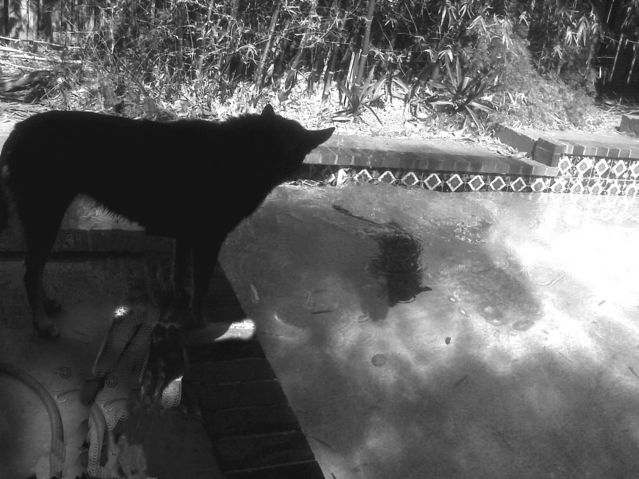Attention
Shifting Perspectives on How Dogs Came to Be Dogs
Recent research helps refine the standard view of dog domestication.
Posted September 23, 2019 Reviewed by Lybi Ma
Despite a steady flow of new papers that chip away at the edifice of “settled science” regarding the domestication of animals, any number of experts, including those whose research contributes to the need for revision, cling to the belief that dogs diverged several tens of thousands of years ago from one or more populations of self-domesticating gray wolves. These wolves managed to convince one or more bands of Stone-Age hunters and gatherers that they were a kinder, friendlier, gentler sort of carnivore than their fellow canids and could be safely welcomed into their tents, yurts, huts, tepees, caves.
At stake here is the continued dominance of what several students of canine domestication have called the “self-taming dump-diver hypothesis”—or some variation thereof. Essentially it holds that a population of ghost wolves worm-crawled their way into our collective consciousness by occupying a niche humans had unconsciously created for an offal eating, garbage scow eager to clean the camp of waste. Such an animal had to be not only unafraid of the biped but also desirous of its attention.
Recent research shows that at an early date, dog-wolves were assisting hunters. They also served as transport and guard animals. Something happened somewhere along the line to turn some wolves into dogs, but what? Suppose we learn that Homo erectus, or Denisovans, had a long-standing relationship with wolves—that we anatomically modern humans learned from our predecessors how to live with them? Uncomfortable with uncertainty, we make up stories, which need only reinforce our prejudices to be deemed true. In this case, the story that between humans and wild wolves lies an enmity so powerful that for humans to invite an unchanged wolf into their homes is (and always has been) tantamount to suicide or murder.

I have long thought that the failure to question the major underlying assumptions of the prevailing theory of dog domestication has made developing a more accurate picture difficult if not impossible. I have written extensively on this topic and rather than repeat myself, I will remind readers that the Siberian fox experiments of Dimitry Belyaev and his followers, begun more than 50 years ago and used to “prove” that the dog is a self-domesticated, neotenic (juvenilized) wolf, are at last being seen for what they represent—possible domestication of a subpopulation of red foxes subjected to intensive human selection, not a freely breeding band of camp—following wolves. Red foxes have been tamed for millennia but not domesticated, perhaps because unlike wolves, they could not make the leap.
Since the dawn of the current millennium, dogs, especially purebred dogs have soared in popularity and price worldwide—and with that popularity comes the growth of the worldwide dog population to an estimated one billion, about 30 percent of them purebred. Research on dogs has grown accordingly, with much of it focused on what makes the bond between dogs and humans so special—especially how humans benefit from having dogs in their lives.
Several years ago, for example (refer to my blogs here, here, and here), researchers in Japan suggested that wolves, in becoming dogs, had hijacked the human mother-infant oxytocin feedback system that makes that bond so special and powerful, except when it is not.
Another recent report identified a mutation in a gene that helps position the eyelid to give dogs those “puppy-dog eyes” that so endear them to us, except when they do not. There seems to be a mania going around that glorifies the virtues of staring into your dog’s eyes as if therein you will discover something profound. But not all dogs and certainly not all humans like to lock eyes, especially with strangers. Some find it threatening, intimidating.
Other researchers have examined what is called hyper-sociability in dogs as playing a part in their transformation from wolves. And then there is older research showing that dogs follow a person’s gaze to a hidden object while wolves do not. Much of this research asks directly or indirectly just how thorough-going that long ago conversion from wild wolf to domestic dog, from "murderous" wolf to attention-craving dog was, and whether it continues now under the direction of humans—and if it is under our direction, do we know what we are doing? Did we ever really know?
The Siberian fox domestication experiment I mentioned earlier is to this day invoked as iron-clad proof that dump-diving wolves had their essential natures changed: they became piebald, lop-eared, curl-tailed, attention-seeking whiners, lacking the wild wolf's robustness and demeanor. They were physically and mentally smaller; they were dogs—now fit to share home and bed with people they no longer threatened.
But dogs are not universally loved—sad to say. Many people consider them ill-mannered or worse—aggressive toward other dogs, animals, and people. They are considered vectors for disease, notably rabies. Even when not spreading disease, they have a tendency under certain circumstances to lead with their teeth, often, I might argue, in self-defense, but many people would consider me wrong.
The best available statistics, mostly compiled for the American Veterinary Medical Association and World Health Organization for the period 2005 to 2018 calculated that the United States averaged 4.5 million dog bites a year; 800,000 of which required hospitalization; 471 of which were fatal. Dr. Niamh Caffrey and colleagues at the University of Calgary published in the July issue of the journal, Animals, an analysis of dog bites in the City of Calgary, which keeps detailed records. They found that “severe bites tended to occur in the homes where the dogs lived, and to be directed towards children and older adults.” I would add that those are the demographics that wolves tend to hunt—the old and young. The researchers also emphasize that any dog is capable of biting under proper circumstances.
Looking at the evidence showing many more people and livestock have been killed by dogs than wolves, I wonder when those self-domesticating wolves were deemed safe enough to be brought out of the cold, what test did they pass to convince the humans they would not kill and eat them?
The standard model holds that domestication involves neoteny, also known as paedomorphosis, which can be defined as changes in the speed and timing of an organism's development such that it retains infantile and juvenile characteristics and behaviors into adulthood or matures early (sexually, for example). Dogs’ jaws, it is said, were smaller than those of wolves, and so their teeth, which did not downsize with their mouths, were crowded and crooked. Similarly, their brains were smaller as befitted a debased wolf.
Charles Darwin first noted changes in appearance and behavior that set domesticated animals apart from their wild forebears; as codified, his observation came to be known as the Domestication Syndrome Hypothesis. The late Raymond Coppinger popularized the notion that the closer a type of dog was in appearance to its wild forebear, the less neotenic it was and the obverse. Coppinger invoked Dimitry Belyaev's fox experiments, and the notion became settled science until Madeleine Geiger submitted her doctoral thesis, Skeletal growth and life history evolution in wild and domesticated animals, to the Department of Zoology at the University of Zurich. Geiger measured growth rates in dogs and wolves, as well as the age of sexual maturity from various periods in dog evolution (modern premodern, and prehistoric). After extensive investigation, Geiger and several of her colleagues “did not find evidence for heterochrony in the investigated groups and conclude that domestic dogs are not paedomorphic wolves.”
I have a sense that Geiger will not go unchallenged because many top scientists are invested in some version of the standard model. But if her findings stand, they should trigger a serious revision of a long-held story told to reveal the mystery of the dog, an animal whose evolution humans have influenced for tens of thousands of years. Despite all the variation in size, form, and physical ability we celebrate in dogs today, splitting them into more than 400 distinct breeds, based on the most narrow of differences—whether their coats are wiry or smooth, for example—genetically and behaviorally dogs share much in common with each other and with wild wolves.
They are not well served by breeders who seek to “refine” them to fit their notion of what "their"breed should be. In some cases, they create dogs unable to perform basic functions like running. If there are dogs today who look and act like perpetual puppies, it is because people have prevented them from expressing their essential dogness. Perhaps a clearer understanding of the dog's evolution will help us better understand what manner of being it is.
References
Here are links to Marc Bekoff's blog, Animal Emotions including interviews with several researchers who challenge the hypothesis: Raymond Pierotti and Brandy R. Fogg, authors of The First Domestication: How Wolves and Humans Coevolved; and an interview with German researchers, Christoph Jung and Daniela Porti, who wrote "Scavenging Hypothesis: Lack of Evidence for Dog Domestication on the Waste Dump."




